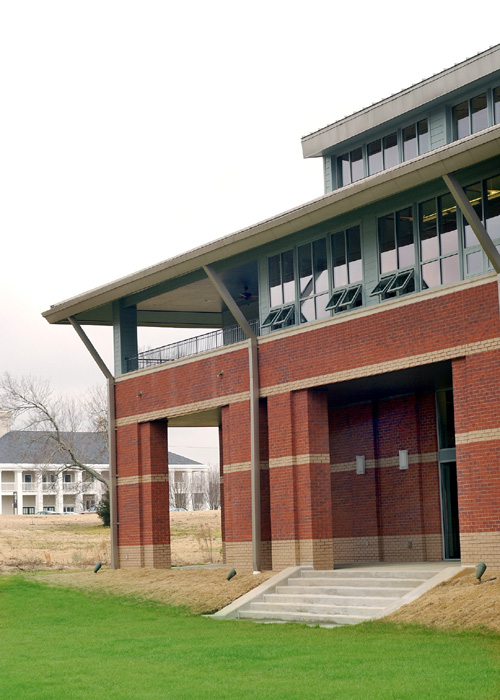Contact: Maridith Geuder

New landscape architecture facility
When landscape architecture faculty members at Mississippi State University were asked to help plan a new home for their department, all appreciated the need to practice what they preach to students.
Their message is that landscapes and structures built by humans can and should operate like natural systems--with no wasted energy. Or, in its most succinct terms, the creations must be sustainable.
Located just off Stone Boulevard on the western side of campus, the realization of their collaborative efforts is an academic complex that joins only a few in the nation considered truly sustainable.
"We wanted a facility that demonstrated to both the members of the campus community and visitors from around the world how we are in harmony with natural ecological systems," said professor Pete Melby, the faculty planning committee chair.
In addition to his teaching duties, Melby co-directs with biological engineer Tom Cathcart MSU's Center for Sustainable Design. Last year, they also collaborated on a book titled "Regenerative Design Techniques: Practical Applications in Landscape Design."
Melby said the landscape architecture faculty team worked closely with lead architects Dale and Associates of Jackson, as well as state Bureau of Buildings officials, to bring the concepts to reality.
The newly opened complex involves three brick-façade buildings that provide space for classrooms and studios accommodating about 250 faculty and students, as well as faculty and administrative offices, for the department's landscape architecture and landscape contracting curriculua.
"The buildings are sited so that they make full use of natural daylight," Melby said. "No room in the buildings would have inadequate lighting, even if the power went out."
Other energy-reducing features include:
--Ground-source heating and cooling expected to reduce utility bills by as much as 50 percent;
--Large building overhangs that will keep buildings 8-10 degrees cooler in the summer;
--Wall and roof designs that won't allow summer heat to penetrate the structure; and
--In cooperation with the Tennessee Valley Authority, a bank of photovoltaic solar panels that provide enough power to run the facility.
Taking energy conservation a step further, the functioning windows will enable the university to turn off heating and cooling sources during the milder months and have only open windows for necessary ventilation.
Also inside the structures, concrete floors assure there are no emissions of volatile organic compounds. In places requiring something other than concrete, the design team chose floor coverings of either recycled rubber tire or natural soybean-based materials.
Outside, Melby added, the surrounding landscape will feature very little mowed grass.
"There will be producing vegetable gardens, prairie grass and themed gardens such as a butterfly garden and a perennials garden," he said. The goal here, he emphasized, will be to "utilize the grounds as both a teaching tool and visitor attraction."
As for parking lots, a separate plan was developed to remove wastewater from the site, including byproducts left from automobiles in adjacent parking lots. Wetland treatment cells, indoor recycling of gray water, the use of cisterns for harvesting water, and even natural treatment of sewage are among other planned water-conserving measures.
"All of the facility's features contribute to our desire to dramatically reduce energy needs and to use less water pumped from dwindling underground reserves," Melby said.
For more information about sustainable design principles, in general, or the new landscape architecture facility, in particular, telephone Melby at (662) 325-3012.